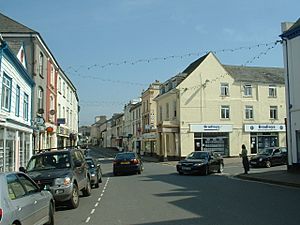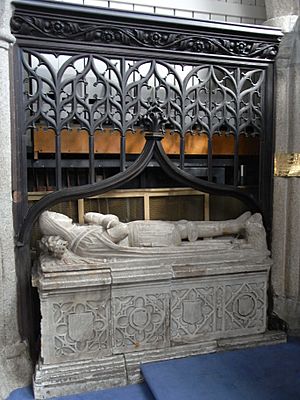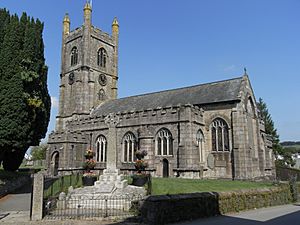Callington facts for kids
Quick facts for kids Callington
|
|
|---|---|
 Fore Street, Callington's main street |
|
| Lua error in Module:Location_map at line 530: Unable to find the specified location map definition: "Module:Location map/data/Cornwall (mainland)" does not exist. | |
| Population | 5,786 (Census 2011) |
| OS grid reference | SX359696 |
| Civil parish |
|
| Unitary authority | |
| Ceremonial county | |
| Region | |
| Country | England |
| Sovereign state | United Kingdom |
| Post town | Callington |
| Postcode district | PL17 |
| Dialling code | 01579 |
| Police | Devon and Cornwall |
| Fire | Cornwall |
| Ambulance | South Western |
| EU Parliament | South West England |
| UK Parliament |
|
Callington (which is Kelliwik in the Cornish language) is a town in eastern Cornwall, England. It is about 7 miles (11 km) north of Saltash. The town is also about 9 miles (14 km) south of Launceston.
In 2011, the town of Callington had a population of 5,786 people. This number grew from 4,783 people in 2001.
Contents
Exploring Callington's Location
Callington is located in eastern Cornwall. It sits between two large moorlands. Dartmoor is to the east, and Bodmin Moor is to the west. The town was once a busy market town for farming. It is at a crossroads of important roads. These include the A388 road and the A390 road.
Kit Hill is a tall hill near Callington. It is about a mile (1.6 km) north-east of the town. Kit Hill rises to 333 meters (1,093 feet) high. From the top, you can see amazing views. You can see Dartmoor, Bodmin Moor, and the River Tamar.
Several small villages are part of Callington parish. These include Bowling Green, Kelly Bray, Frogwell, and Downgate.
Callington's Railway History
Callington once had its own railway station. It was the end of a train line from Bere Alston. This line connected to the main railway that went from Exeter to Plymouth. The railway line past Gunnislake to Callington closed in the 1960s. This happened because not many people used it. Also, the last parts of the line had steep hills and sharp turns.
Today, you can still travel by train on the Tamar Valley Line. This line goes from Plymouth to Gunnislake. Trains reverse direction at Bere Alston. The line mostly follows the River Tamar. Gunnislake is the closest train station to Callington. The nearest main train station is in Saltash.
Callington's Economy
Two big food companies are the largest employers in Callington. These are Ginsters and The Cornwall Bakery. Both companies are owned by Samworth Brothers. Ginsters uses local ingredients for many of its products. They buy potatoes and vegetables from nearby farmers.
The Old Clink is a historic building on Tillie Street. It was built in 1851 as a place to hold people who caused trouble. Now, it is used as offices for a local driving school.
A Tesco supermarket opened in Callington in 2010. It provides jobs for 200 local people.
Callington's Past and Old Sites

Some people think Callington might be the ancient place called Celliwig. This place is linked to the legend of King Arthur. There are old monuments nearby. These include Castlewitch Henge, which is a large circular earthwork. There is also Cadsonbury Iron Age hillfort. Another site is Dupath Well, built in 1510. It stands on the spot of an old sacred spring.
Callington was mentioned in the Domesday Book in 1086. This was a very old survey of England. It showed that the area had land for many farms and people.
In the 19th century, Callington was a very important mining area. Silver was found nearby in Silver Valley. Today, you can still see signs of the old mines. However, no mines are active now. Granite is still dug up at Hingston Down.
Callington used to have its own special way of electing members to Parliament. This was called a "rotten borough." It meant that a small number of people could choose the representatives. This system was changed by the Reform Act 1832. Now, Callington is part of the South East Cornwall constituency.
St Mary's Church was first a smaller chapel. It became a church in 1438. It has two aisles and a strong tower. A second north aisle was added in 1882. The church has old wooden roofs. Inside, you can see a beautiful brass memorial for Nicholas Assheton and his wife from 1466.
In the churchyard, there is an old stone cross. It has carvings of figures on its four sides. The heads of these figures were removed a long time ago.
How Callington is Governed
Callington is one of the few towns that still has a "Portreeve." This was originally a medieval officer who collected money. Today, it is an honorary title. The Portreeve is the chairman of the town council. Callington Town Council has twelve members. They look after the civil parish of Callington.
Callington's Growth
In recent years, many new homes have been built in Callington. More housing, including homes for social housing, is planned. The nearby village of Kelly Bray has almost doubled in size. New houses are still being built there. A housing area called Meadowbrook is currently under construction.
Twin Towns
Callington is twinned with two towns. One is Guipavas in Brittany, France. The other is Barsbüttel near Hamburg in Germany. Callington also has unofficial friendly links with Keila in Estonia.
Local Media
Local TV news for Callington comes from BBC South West and ITV West Country. Radio stations include BBC Radio Cornwall (95.2 FM), Heart West (105.1 FM), and Pirate FM (102.2 FM). The local newspaper is the Cornish & Devon Post. It is published every Thursday.
Sports in Callington
Callington has both football and cricket teams. Callington Town Football Club started in 1989. They have four adult teams that play in different leagues. All their games are played at Marshfield Parc, next to Callington Community College.
Callington Cricket Club has three teams. They play their games at Moores Park. Callington Badminton Club plays on Fridays at the Community College sports hall. They have men's, ladies', and mixed teams. The club welcomes people of all ages and skill levels.
Callington Bowling Club started in 1946. It is located at Chantry Park. The club has men's and ladies' teams that play in various leagues. They also have mixed teams that play during the winter.
Cornish Wrestling
Cornish wrestling tournaments used to be held in Callington. These events offered prizes to the winners in the 1800s.
See also
 In Spanish: Callington para niños
In Spanish: Callington para niños


